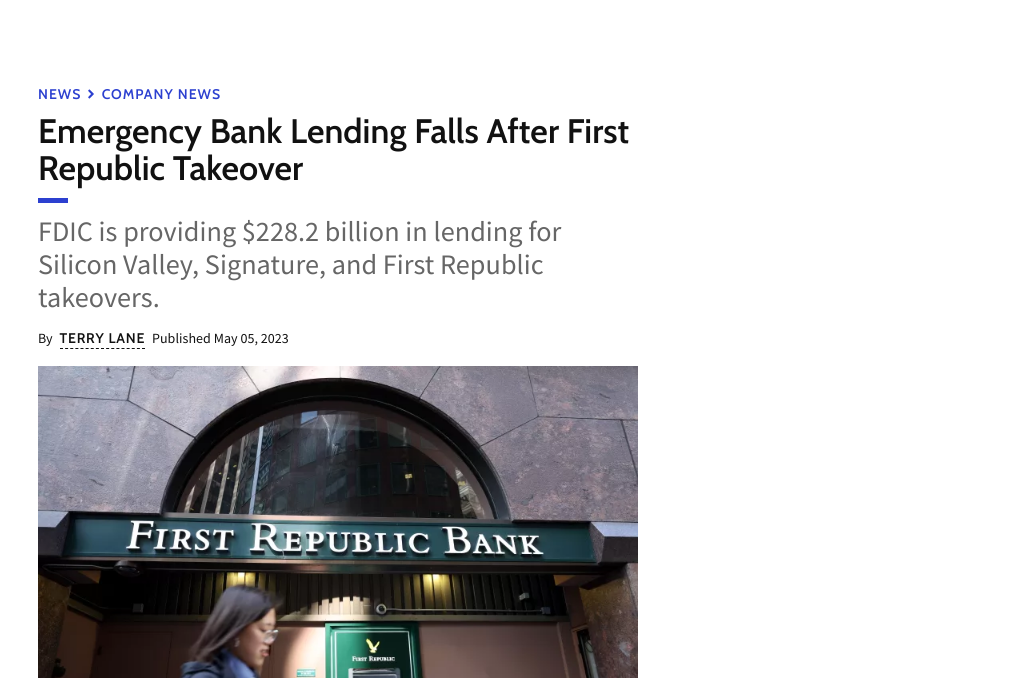JPMorgan Chase & Co. (NYSE: JPM) is a leading financial services firm based in the United States, with operations worldwide. As of March 31, 2023, JPMorgan Chase had $3.7 trillion in assets and $303 billion in stockholders’ equity.[0] The company is a leader in investment banking, financial services for consumers and small businesses, commercial banking, financial transaction processing, and asset management.[0] Under the J.P. Morgan and Chase brands, the firm serves millions of customers in the U.S., and many of the world’s most prominent corporate, institutional, and government clients globally.[0]
In recent news, the struggling First Republic Bank was seized by federal regulators and promptly sold to JPMorgan Chase. Reports show that First Republic had around $230 billion in financial assets that quickly evaporated, making it the second-largest bank collapse in US history, exceeding the recent bankruptcies of Silicon Valley Bank and Signature Bank.[1] First Republic was among the US regional banks most affected by the loss of confidence in the banking sector, as customers panicked following the downfall of SVB and Signature Bank, two mid-sized lenders, in March.[2]
First Republic Bank had total assets of around $229.1 billion and total deposits of $103.9 billion, as of April 13, 2023.[3] Not only did JPMorgan Chase Bank, National Association take on all of the deposits, but they also made a deal to acquire nearly all of First Republic Bank’s assets.
First Republic was bought by JPMorgan Chase after regulators took control of the bank. Borrowing from a federal program set up to help banks in the wake of three recent failures plummeted after First Republic Bank was taken over by the Federal Deposit Insurance Corp. (FDIC) and sold to JPMorgan, indicating that First Republic accounted for much of the emergency borrowing after the recent bank turmoil.[4]
Despite some of the nation’s largest banks coming together to help First Republic in mid-March by placing $30 billion in uninsured deposits with the struggling lender, customers fled in droves, pulling roughly $100 billion in deposits in March alone, as the bank revealed in its first-quarter earnings report last week.[2] First Republic’s total deposits at the end of the month were $74.4 billion, not including the $30 billion in time deposits that were part of the rescue attempt. This is a significant decrease from the $173.5 billion they had on March 9, the day before SVB’s failure.
By the close of 2022, uninsured deposits made up two-thirds of the total deposits at First Republic.[5] Following the failure of SVB and Signature Bank, numerous affluent clients deserted First Republic out of concern for the safety of their funds.[5] First Republic witnessed a significant drop in its deposits by over $100 billion by the end of March, exclusive of the $30 billion deposited by 11 major banks on March 16 to help stabilize the situation. The bank had recorded total deposits worth $176.4 billion at the close of the preceding year.
First Republic reported in their financial statements for the first quarter that deposits worth around $100 billion were withdrawn within days following the collapse of SVB. SVB’s failure was caused by withdrawals exceeding $40 billion the day prior.[6] That double whammy—depositors fleeing, asset portfolio underwater—led to First Republic’s demise.[6]
The FDIC and JPMorgan Chase Bank, National Association, are also entering into a loss-share transaction on single-family, residential, and commercial loans it purchased of the former First Republic Bank.[3] The FDIC as receiver and JPMorgan Chase Bank, National Association, will share in the losses and potential recoveries on the loans covered by the loss-share agreement.[3] The loss-share transaction is projected to maximize recoveries on the assets by keeping them in the private sector.[3] It is anticipated that the transaction will reduce any interruptions for customers who have taken out loans.[3] Furthermore, JPMorgan Chase Bank, National Association, shall take on the responsibility for all Qualified Financial Contracts.[0]
JPMorgan Chase’s move to acquire most of First Republic Bank’s assets this week hasn’t stemmed investor concerns about the financial prospects for other regional lenders. Despite JPMorgan Chase’s successful acquisition of First Republic on Monday, aimed at calming market concerns over financial sector instability, economists continue to express concerns over stricter lending requirements.
0. “JPMorgan Chase acquires substantial majority of assets and assumes certain liabilities of First Republic Bank” JPMorgan Chase, 1 May. 2023, https://www.jpmorganchase.com/ir/news/2023/jpmc-acquires-substantial-majority-of-assets-and-assumes-certain-liabilities-of-first-republic-bank
1. “A New Fed Report Holds a Clue on Why Banks Are Collapsing | Jon Miltimore” Foundation for Economic Education, 6 May. 2023, https://fee.org/articles/a-new-fed-report-holds-a-clue-on-why-banks-are-collapsing/
2. “U.S. Banking System: The Great Consolidation” Statista, 2 May. 2023, https://www.statista.com/chart/29901/number-of-us-commercial-banks-and-branches/
3. “PR-34-2023 5/1/2023” FDIC, 1 May. 2023, https://www.fdic.gov/news/press-releases/2023/pr23034.html
4. “First Republic Takeover Cuts Emergency Bank Lending” Investopedia, 5 May. 2023, https://www.investopedia.com/emergency-bank-lending-falls-after-first-republic-7489178
5. “Why First Republic failed, and what it means for the rest of the banking industry” Business Insider, 1 May. 2023, https://www.businessinsider.com/why-first-republic-failed-what-means-rest-banking-industry-2023-5
6. “Why First Republic Is Failing” The Atlantic, 30 Apr. 2023, https://www.theatlantic.com/ideas/archive/2023/04/why-first-republic-failing/673914/
